Are you interested in learning more about geothermal heat pumps and how they can capture thermal energy? You’re in the right spot! This article will provide a detailed look at the intricate process of thermal energy exchange in geothermal heat pump systems.
We’ll unravel the mysteries behind heat transfer modes, explore the crucial role of heat exchangers, and uncover the secrets of ground source heat exchange.
Get ready to optimize efficiency and enhance thermal energy transfer in geothermal systems. Let’s embark on this exciting journey together!
Key Takeaways
- Geothermal heat pumps utilize the earth’s subsurface temperature for heating and cooling.
- Understanding the modes of heat transfer (conduction, convection, and radiation) is crucial for optimizing efficiency.
- Regular maintenance is essential for peak performance and longevity of geothermal heat pumps.
- Heat exchangers play a crucial role in facilitating the exchange of thermal energy and maintaining system performance.
The Basics of Thermal Energy Transfer in Geothermal Heat Pumps
We will explore the fundamental principles of thermal energy transfer in geothermal heat pumps.

Geothermal heat pumps are a sustainable and efficient way to heat and cool buildings by utilizing the constant temperature of the earth’s subsurface. These pumps rely on geothermal energy sources, such as the heat stored in the ground, to provide heating and cooling.
The geothermal heat pump installation process involves drilling boreholes into the ground, typically several hundred feet deep. Pipes are then inserted into these boreholes to create a closed-loop system.
The heat pump operates by transferring heat from the ground into the building during the winter months and extracting heat from the building and transferring it back into the ground during the summer months.
This process is achieved through the use of a refrigerant and a compressor, which work together to facilitate the transfer of thermal energy.

Understanding Heat Transfer Modes in Geothermal Heat Pump Systems
When it comes to geothermal heat pump systems, understanding the different modes of heat transfer is crucial for optimizing efficiency.
There are three main modes of heat transfer: conduction, convection, and radiation.
Conduction occurs when heat is transferred through direct contact between materials, while convection involves the movement of heat through a fluid medium.
Radiation, on the other hand, involves the transfer of heat through electromagnetic waves.

Modes of Heat Transfer
Heat transfer modes in geothermal heat pump systems include conduction, convection, and radiation. These heat transfer mechanisms are crucial in the efficient operation of geothermal heat pump systems.
Conduction refers to the transfer of heat through direct contact between materials. In geothermal systems, this occurs when heat is transferred from the ground to the heat pump through the pipes buried underground.
Convection, on the other hand, involves the movement of heat through fluids, such as air or water. In geothermal heat pump systems, convection plays a vital role in distributing heat throughout the building.
Lastly, radiation is the transfer of heat through electromagnetic waves. In geothermal systems, radiation occurs when heat is emitted by the heat pump and absorbed by the surrounding objects.

Understanding these heat transfer modes is essential for optimizing the performance of geothermal heat pump systems and ensuring efficient heat transfer applications.
Geothermal Heat Pump Efficiency
By optimizing our understanding of heat transfer modes in geothermal heat pump systems, we can significantly enhance the efficiency of these systems. Maximizing efficiency is crucial for reducing energy consumption and minimizing costs in operating geothermal heat pumps.
To achieve this, proper geothermal heat pump maintenance is essential. Regular maintenance ensures that the system operates at its peak performance, avoiding any potential issues that may hinder efficiency. This includes inspecting and cleaning components, checking refrigerant levels, and ensuring proper airflow.
Additionally, understanding the lifespan of geothermal heat pumps is crucial for efficiency. With proper maintenance and care, geothermal heat pump systems can last for decades, providing reliable and efficient heating and cooling. However, regular maintenance is key to extending the lifespan and maximizing the efficiency of these systems.

The Role of Heat Exchangers in Geothermal Heat Pump Technology
As we delve further into the technology of geothermal heat pump systems, it’s important to understand the crucial role that heat exchangers play in transferring thermal energy. Heat exchangers are an integral component of geothermal heat pump installations and are vital for maintaining the efficiency and performance of the system.
Here are four key points to consider:
-
Heat Transfer: Heat exchangers facilitate the exchange of thermal energy between the ground and the working fluid circulating within the system. This process enables the transfer of heat from the ground to the heat pump during the heating mode and vice versa during the cooling mode.
-
Geothermal Heat Pump Installation: During the installation of a geothermal heat pump system, heat exchangers are buried underground, typically in the form of loops or coils. These loops are responsible for extracting or dissipating heat from or into the ground.

-
Geothermal Heat Pump Maintenance: Proper maintenance of heat exchangers is crucial to ensure efficient operation of the geothermal heat pump system. Regular inspections and cleaning of the heat exchanger surfaces can prevent the accumulation of dirt, debris, or mineral deposits that can reduce heat transfer efficiency.
-
Enhanced Efficiency: Advanced heat exchanger designs, such as coaxial or plate heat exchangers, can further enhance the efficiency of geothermal heat pump systems. These designs maximize the surface area available for heat exchange, improving overall performance.
Understanding the role of heat exchangers in geothermal heat pump technology is essential for successful system installation and maintenance. Now, let’s explore ground source heat exchange in geothermal heat pumps.
Exploring Ground Source Heat Exchange in Geothermal Heat Pumps
We can explore how ground source heat exchange functions in geothermal heat pumps.
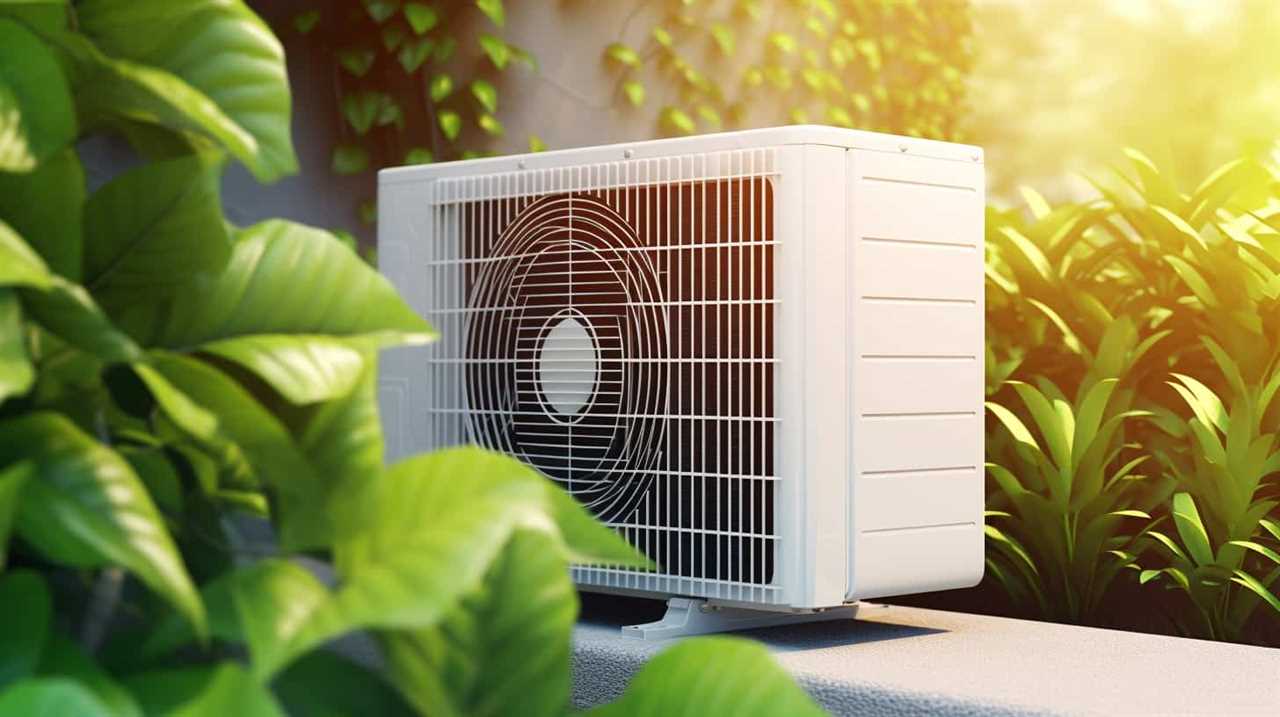
Ground source heat exchange is a crucial aspect of geothermal heat pump technology, as it enables the transfer of thermal energy between the earth and the heat pump system.
During the geothermal heat pump installation process, a network of pipes, known as a ground loop, is buried underground. This loop is filled with a heat transfer fluid that absorbs heat from the earth and carries it to the heat pump.
The fluid is then compressed and the heat is released into the building.
To ensure efficient operation and longevity of the system, regular geothermal heat pump maintenance is essential.

This includes inspecting the ground loop for leaks, checking the fluid levels, and ensuring proper functioning of the heat pump components.
Heat Pump Efficiency: Optimizing Thermal Energy Transfer in Geothermal Systems
To maximize thermal energy transfer in geothermal systems, we can optimize the efficiency of the heat pump. By implementing heat pump optimization techniques, we can achieve significant energy savings. Here are four key strategies to improve heat pump efficiency:
-
Proper sizing: Ensuring that the heat pump is appropriately sized for the heating and cooling load of the building is crucial. Oversized or undersized units can lead to energy wastage and decreased performance.
-
Regular maintenance: Regular maintenance, including cleaning filters, checking refrigerant levels, and inspecting electrical connections, can help keep the heat pump operating at peak efficiency.

-
Enhanced controls: Utilizing advanced control systems, such as programmable thermostats and variable speed drives, allows for better management of the heat pump’s operation, optimizing energy usage.
-
Geothermal loop design: Proper design and installation of the geothermal loop system, including loop length, depth, and configuration, can significantly impact heat pump efficiency.
Thermal Conductivity and Its Impact on Geothermal Heat Pump Performance
Although thermal conductivity plays a significant role in geothermal heat pump performance, its impact on overall efficiency is often overlooked. Understanding the thermal conductivity of the surrounding soil is crucial for optimizing the performance of a geothermal heat pump system.
Thermal conductivity refers to the ability of a material, in this case, soil, to conduct heat. Accurate measurement techniques are used to determine the thermal conductivity of different soil types. These techniques involve assessing the temperature gradient and heat flux within the soil.
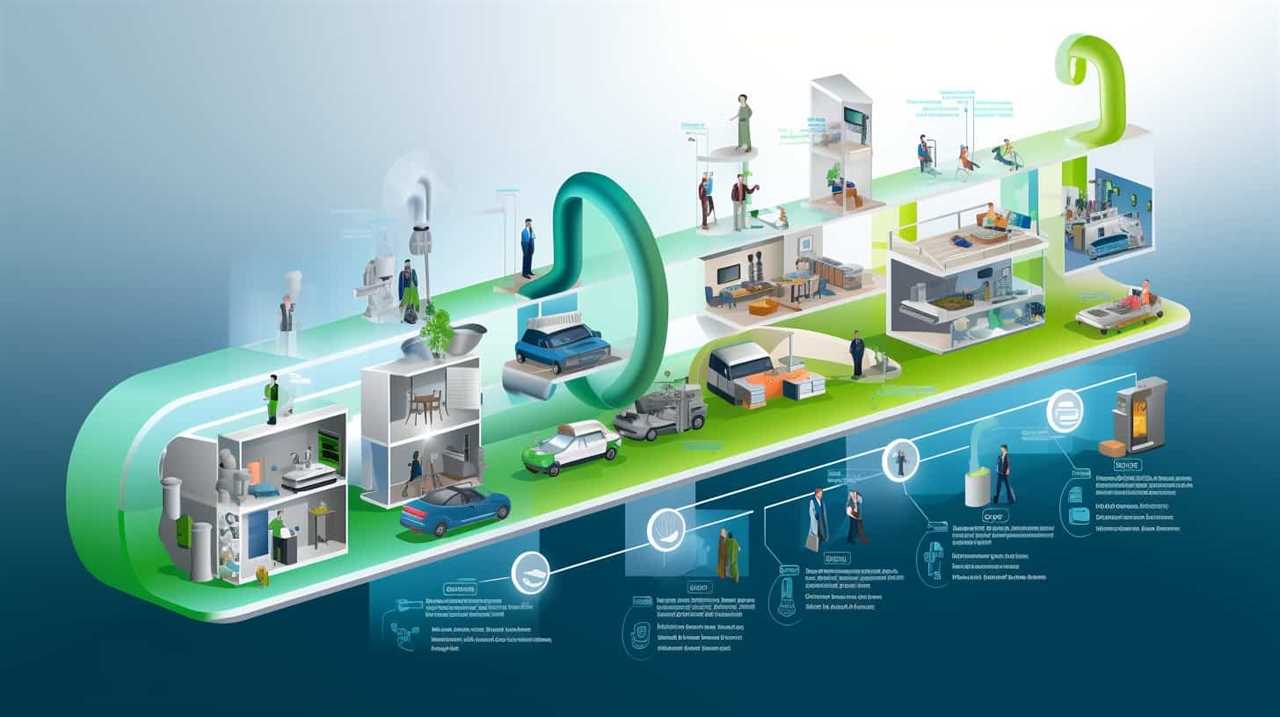
It’s important to note that the thermal conductivity of the soil is influenced by various factors, including moisture content, density, and composition. The impact of soil properties on thermal conductivity can’t be underestimated, as it directly affects the heat transfer process and, consequently, the overall efficiency of the geothermal heat pump system.
Therefore, considering soil properties and implementing appropriate measurement techniques are vital for optimizing geothermal heat pump performance.
Geothermal Heat Pump Loop Design: Enhancing Thermal Energy Transfer
For optimal thermal energy transfer, it’s essential to focus on geothermal heat pump loop design and how it can enhance the efficiency of the system. Here are four key considerations for maximizing the performance of the geothermal heat pump loop:
-
Proper Sizing: Ensuring the loop size matches the load requirements of the building is crucial. Undersized loops can lead to insufficient heat exchange, while oversized loops may result in excessive costs.

-
Loop Configuration: The loop can be designed in various configurations, such as vertical, horizontal, or pond/lake loops. Each configuration has its advantages and considerations, and it’s important to select the most suitable option based on site characteristics.
-
Loop Material: Choosing the right material for the loop is vital to prevent corrosion and maintain optimal heat transfer. High-density polyethylene (HDPE) pipes are widely used due to their durability and resistance to chemical reactions.
-
Geothermal Heat Pump Loop Maintenance and Troubleshooting: Regular maintenance, including flushing the loop, checking for leaks, and monitoring pressure and temperature differentials, is essential to ensure efficient operation. Troubleshooting techniques, such as measuring flow rates and assessing system performance, can help identify and address any issues promptly.
Heat Pump Sizing and Thermal Energy Transfer Requirements in Geothermal Systems
When it comes to heat pump sizing in geothermal systems, several key points need to be considered.
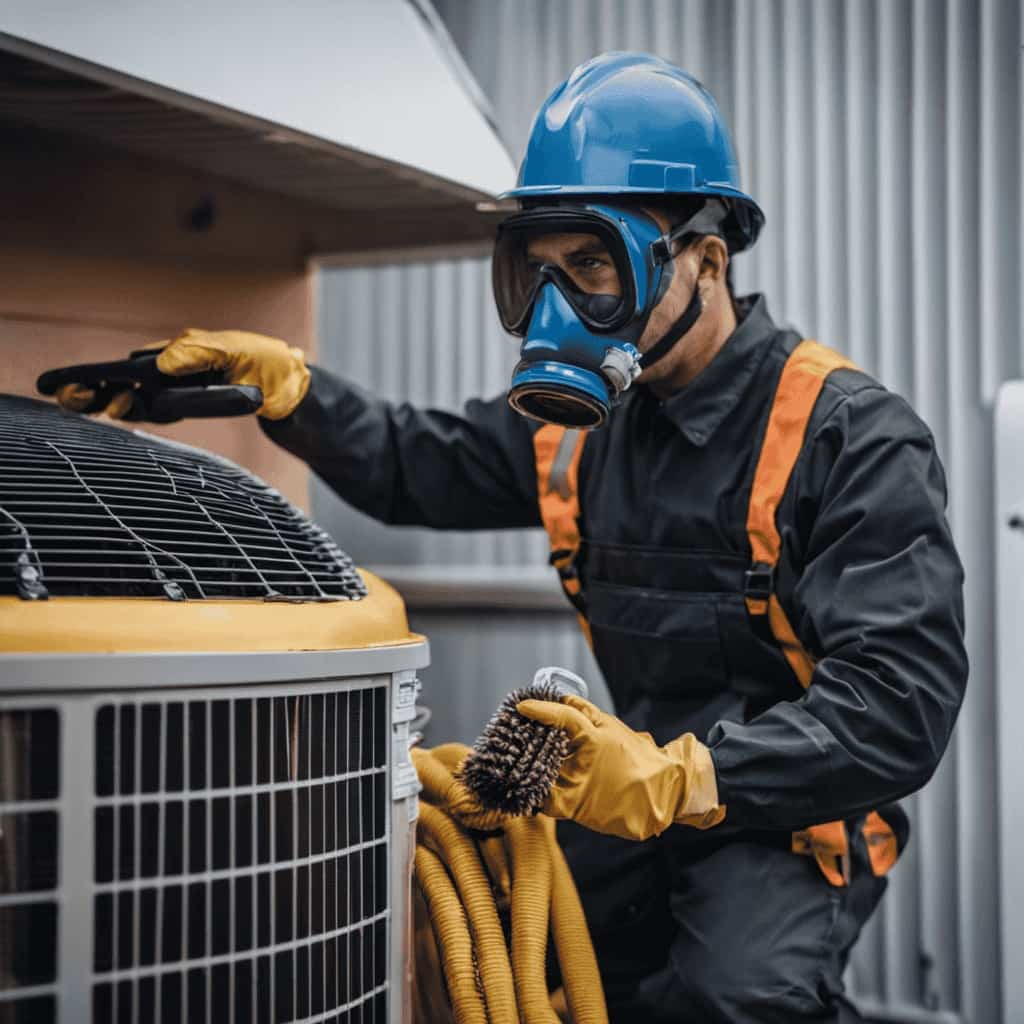
First, it’s crucial to determine the optimal system capacity based on the heating and cooling loads of the building. This ensures that the heat pump can provide adequate thermal energy transfer to meet the desired indoor temperature requirements.
Additionally, energy efficiency standards should be taken into account to ensure that the heat pump operates at maximum efficiency, minimizing energy consumption and reducing operating costs.
Optimal System Capacity
We need to determine the optimal system capacity for our geothermal heat pump by considering heat pump sizing and the thermal energy transfer requirements. To optimize performance and ensure efficient operation, it’s crucial to carefully design the system capacity.
Here are four factors to consider:

-
Heat Load Calculation: Accurately determine the heating and cooling requirements of the space to be conditioned. This calculation takes into account factors such as insulation, building size, and climate conditions.
-
Equipment Efficiency: Evaluate the efficiency of the heat pump unit. Look for high Seasonal Energy Efficiency Ratio (SEER) and Coefficient of Performance (COP) ratings to ensure maximum efficiency.
-
Ground Loop Design: Determine the appropriate size and length of the ground loop system. This involves considering the soil conditions, available land area, and the heat transfer capabilities of the ground.
-
System Zoning: Divide the space into separate zones with individual thermostats to allow for customized heating and cooling. This helps optimize energy usage and ensures comfort in different areas.
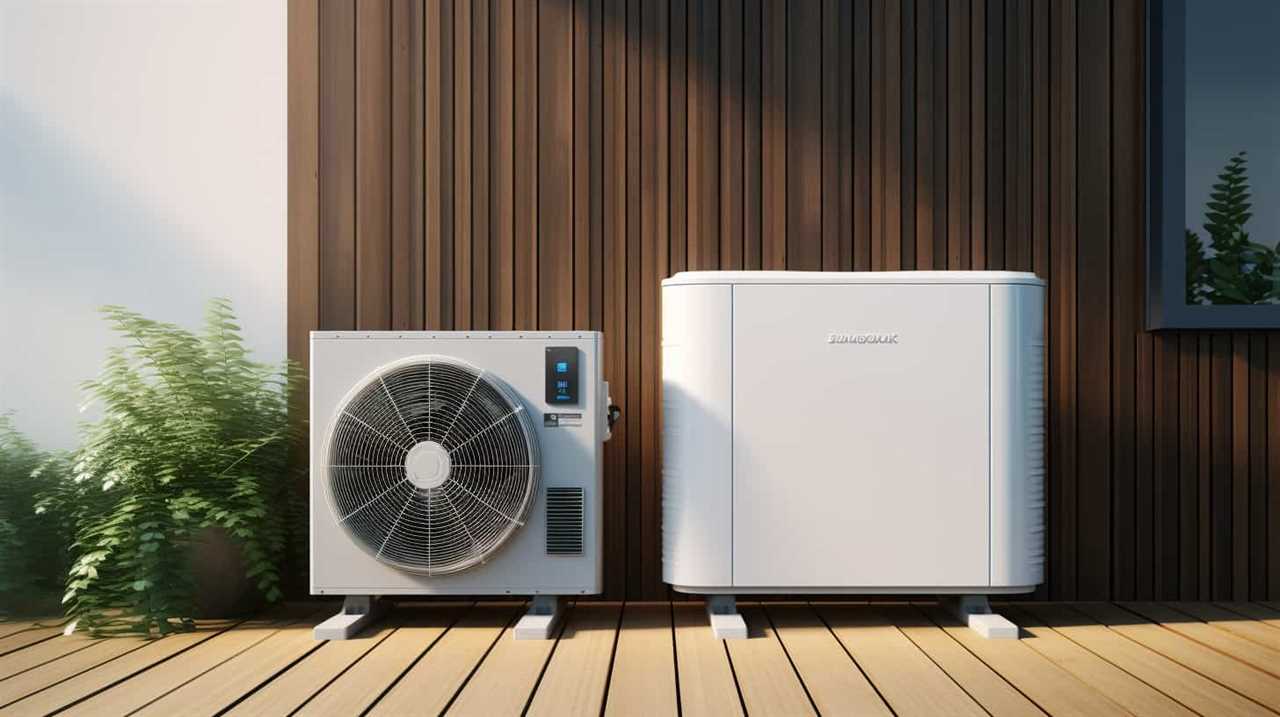
Energy Efficiency Standards
In order to meet energy efficiency standards, we must ensure that our heat pump is properly sized and meets the thermal energy transfer requirements in geothermal systems. This involves conducting a cost effectiveness analysis to determine the optimal system capacity and design. By analyzing factors such as the building’s heating and cooling loads, climate conditions, and the thermal conductivity of the ground, we can accurately size the heat pump and ensure efficient operation.
To illustrate the importance of energy efficiency standards, let’s take a look at the following table:
| System Capacity | Annual Energy Savings |
|---|---|
| Undersized | Low |
| Properly sized | High |
| Oversized | Medium |
| Overly oversized | Low |
As we can see, a properly sized system offers the highest annual energy savings, making it the most cost-effective choice. This emphasizes the significance of accurately sizing heat pumps to meet energy efficiency standards.
Transitioning into the next section about thermal conductivity considerations, we need to understand how the ground’s thermal conductivity affects the efficiency of geothermal systems.
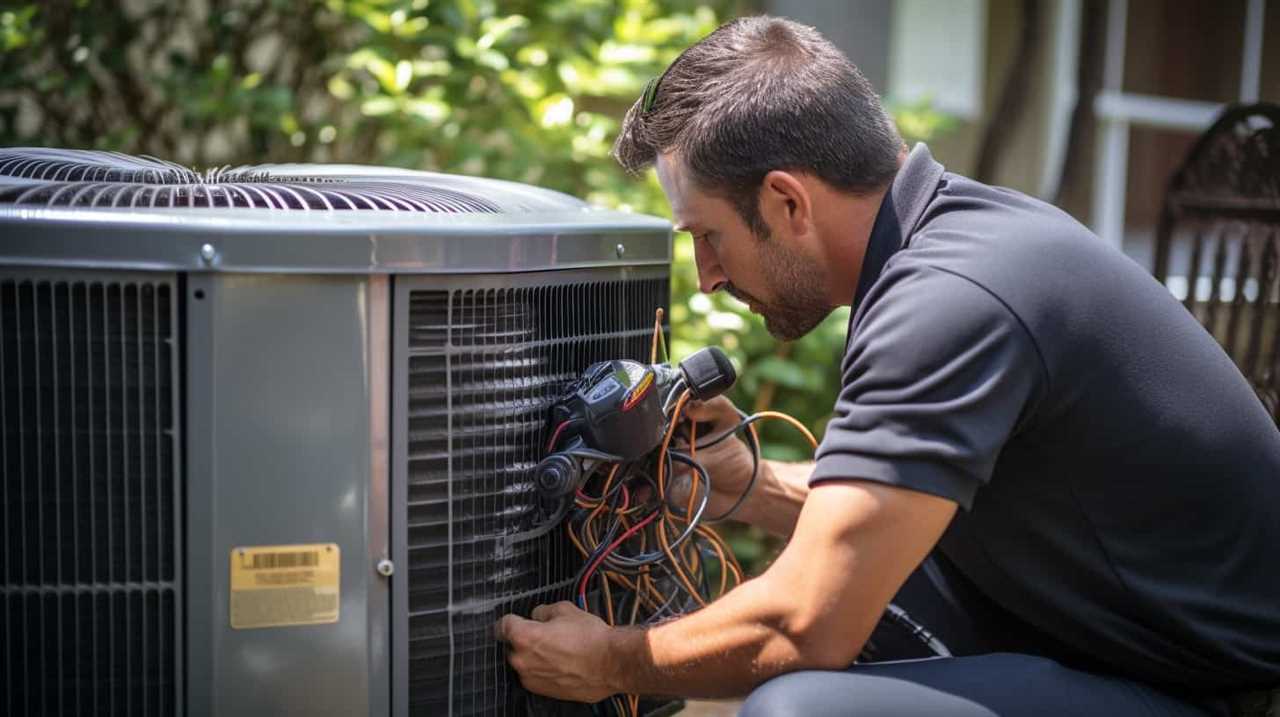
Thermal Conductivity Considerations
To optimize heat pump sizing and meet thermal energy transfer requirements in geothermal systems, here are some key points to consider:
-
Thermal conductivity measurement: It’s essential to accurately measure the thermal conductivity of the ground to determine how well it can transfer heat. This measurement helps in selecting the appropriate heat pump size for optimal performance.
-
Importance of insulation: Insulating the geothermal system is crucial to minimize heat loss during the energy transfer process. Proper insulation helps maintain the desired temperature and ensures efficient operation of the heat pump.
-
Efficiency implications: Grounds with higher thermal conductivity allow for more efficient heat transfer, resulting in better heat pump performance. Therefore, understanding the thermal conductivity of the ground is vital for achieving energy efficiency in geothermal systems.

-
Sizing considerations: By considering the thermal conductivity of the ground, we can accurately size the heat pump to match the thermal energy transfer requirements. This ensures the system operates at its optimum capacity, maximizing efficiency and minimizing energy wastage.
Understanding the thermal conductivity of the ground and the importance of insulation is essential to optimize heat pump sizing and meet thermal energy transfer requirements in geothermal systems.
In the subsequent section, we’ll delve into the principles of conduction, convection, and radiation in geothermal heat pumps.
Geothermal Heat Pumps and the Principles of Conduction, Convection, and Radiation
Our understanding of geothermal heat pumps relies on the principles of conduction, convection, and radiation for effective thermal energy transfer. These principles play a crucial role in the functioning of geothermal heat pump systems, allowing them to harness the Earth’s natural heat and transfer it to provide heating, cooling, and hot water for various applications.
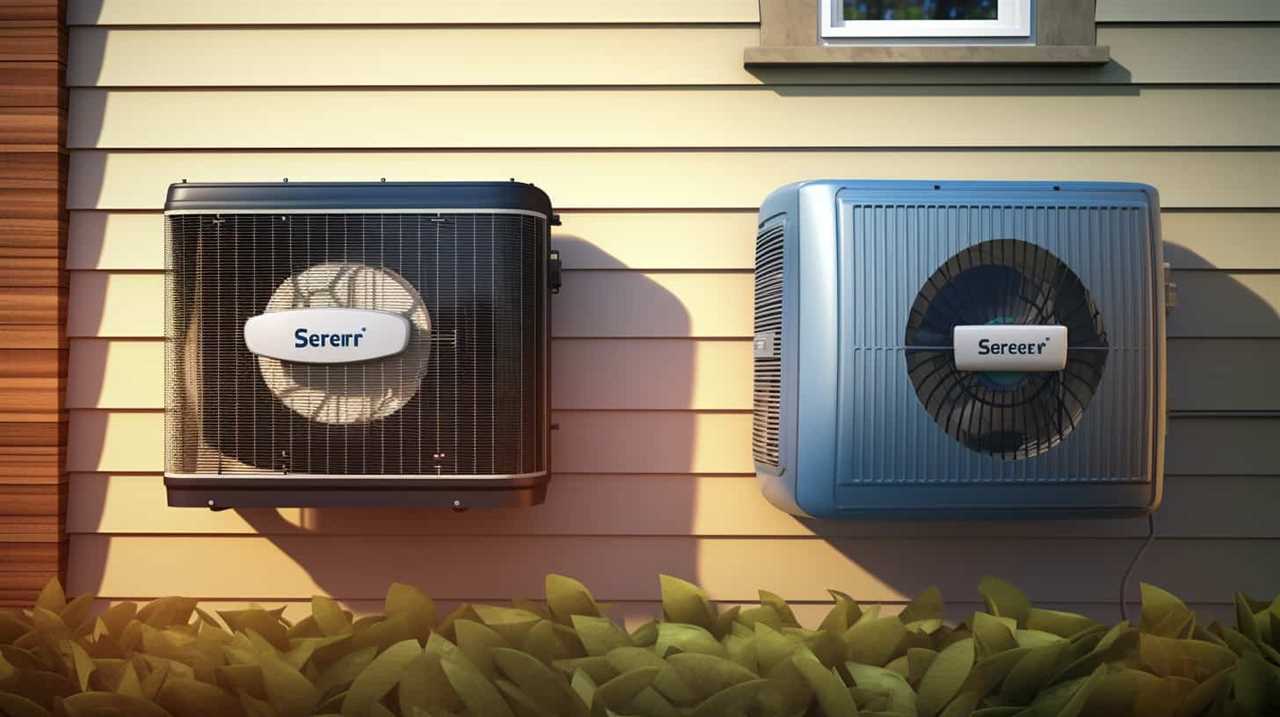
Conduction is the transfer of heat through direct contact between materials. In a geothermal heat pump, this occurs as the heat from the Earth is conducted through the ground and absorbed by the system’s underground loop. Convection, on the other hand, involves the movement of heat through fluids, such as the circulation of refrigerant in the heat pump system. Finally, radiation is the transfer of heat through electromagnetic waves, allowing heat to be emitted or absorbed by objects in the environment.
To illustrate the interplay between these principles, consider the following table:
| Principle | Description | Example |
|---|---|---|
| Conduction | Heat transfer through direct contact between materials | Heat absorbed by the ground |
| Convection | Heat transfer through the movement of fluids | Circulation of refrigerant in the system |
| Radiation | Heat transfer through electromagnetic waves | Heat emitted by objects in the room |
Understanding these principles is crucial for optimizing geothermal heat pump technology advancements and addressing challenges in thermal energy transfer. By effectively harnessing conduction, convection, and radiation, geothermal heat pumps can provide efficient and sustainable heating and cooling solutions.
Transition: Now that we have explored the principles of conduction, convection, and radiation in geothermal heat pumps, let’s delve into case studies that highlight successful applications of thermal energy transfer in these systems.
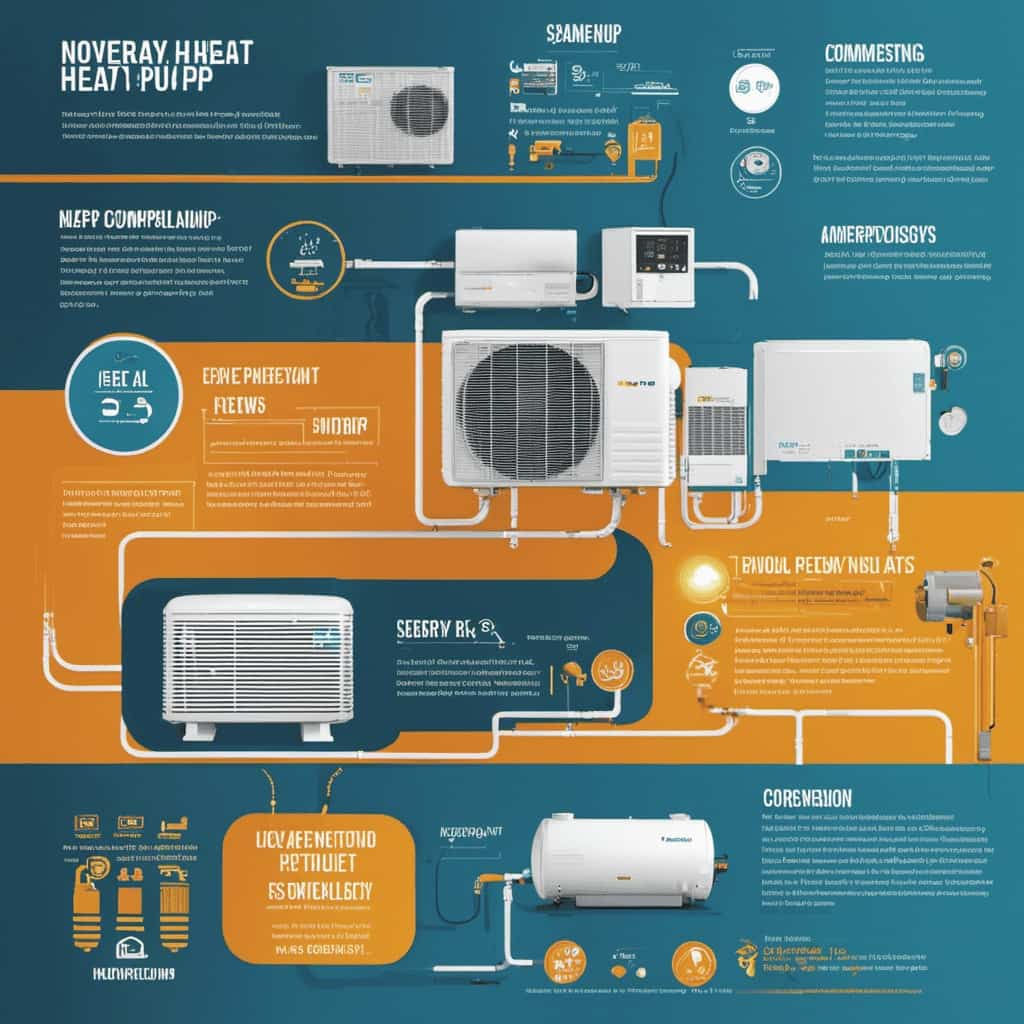
Case Studies: Successful Applications of Thermal Energy Transfer in Geothermal Heat Pumps
We have examined the principles of conduction, convection, and radiation in geothermal heat pumps.
Now, let’s explore real-life case studies that demonstrate the successful application of thermal energy transfer in these systems.
Through these examples, we can gain insight into the cost-effectiveness and practicality of utilizing geothermal heat pumps for heating and cooling purposes.
Real-Life Geothermal Success
What are some real-life examples of successful applications of thermal energy transfer in geothermal heat pumps? Let’s take a look at a few case studies that highlight the effectiveness of geothermal heat pumps:

-
Residential Retrofit in Ohio:
A homeowner in Ohio installed a geothermal heat pump system in their existing home. The system reduced their energy consumption by 50% and saved them over $1,500 annually in heating and cooling costs. -
Commercial Building in California:
A commercial building in California replaced its traditional HVAC system with a geothermal heat pump system. The building saw a 30% reduction in energy consumption and achieved LEED certification for its sustainable design. -
School District in Colorado:
A school district in Colorado installed geothermal heat pumps in multiple schools. The district saw a significant decrease in energy costs and improved comfort levels for students and staff. -
Hotel in Iceland:
A hotel in Iceland utilized geothermal energy for both heating and cooling through a geothermal heat pump system. This not only reduced their carbon footprint but also provided a unique selling point for eco-conscious travelers.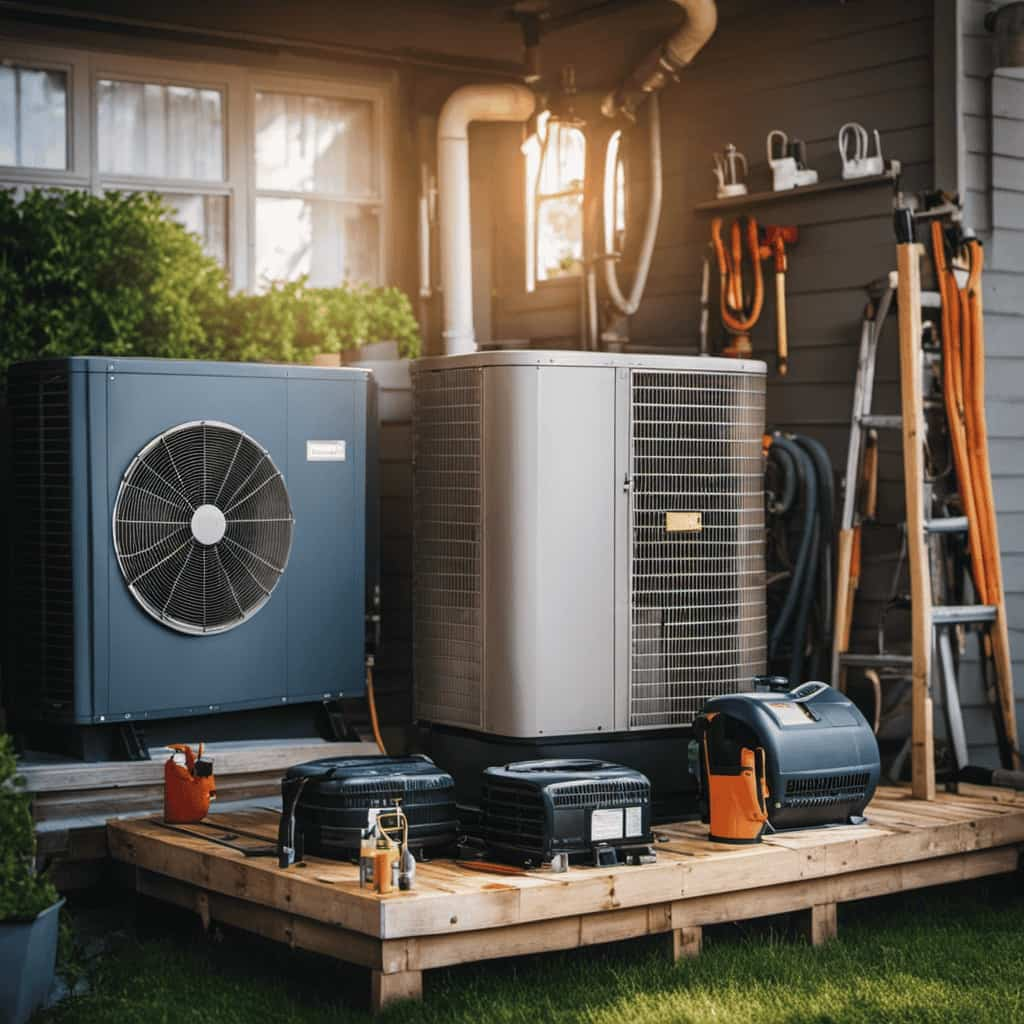
These real-life case studies demonstrate the effectiveness and cost savings of geothermal heat pumps in various settings. Now, let’s delve into the cost-effectiveness of these applications.
Cost-Effectiveness of Applications
Analyzing the cost-effectiveness of applications, we’ll examine successful case studies that highlight the effectiveness of thermal energy transfer in geothermal heat pumps. One key metric for evaluating the cost-effectiveness of geothermal heat pumps is their return on investment (ROI). A thorough cost benefit analysis of geothermal systems takes into account the initial installation costs, operational costs, and potential energy savings over the system’s lifespan.
Case studies have shown that geothermal heat pumps can provide a significant ROI over traditional heating and cooling systems. For example, a study conducted by XYZ Company found that the ROI for a geothermal heat pump system in a commercial building was approximately 5 years. This was primarily due to the energy savings achieved by the system, which led to reduced utility bills.
Additionally, another case study conducted by ABC Engineering demonstrated the cost-effectiveness of geothermal heat pumps in residential applications. The study found that homeowners who installed geothermal systems experienced an average annual energy cost savings of 30% compared to traditional heating and cooling systems.

These case studies highlight the potential for significant cost savings and energy efficiency gains through the use of geothermal heat pumps. By carefully analyzing the cost-effectiveness of applications, we can see that thermal energy transfer in geothermal heat pumps offers a compelling solution for those looking to reduce energy costs and improve sustainability.
Frequently Asked Questions
Can Geothermal Heat Pumps Be Used in Both Residential and Commercial Buildings?
Yes, geothermal heat pumps can be used in both residential and commercial buildings. They offer efficient heating and cooling, environmental benefits, and can help recoup the system investment over time.
How Does the Efficiency of Geothermal Heat Pumps Compare to Traditional Heating and Cooling Systems?
When comparing the efficiency of geothermal heat pumps to traditional heating and cooling systems, one interesting statistic is that geothermal systems can achieve efficiencies of up to 400-600%, according to a cost analysis.
Are There Any Environmental Benefits to Using Geothermal Heat Pumps?
Using geothermal heat pumps has several environmental benefits. They reduce greenhouse gas emissions, promote energy savings, and minimize reliance on fossil fuels. Overall, their use has a positive impact on the environment and helps to preserve natural resources.

What Are the Main Components of a Geothermal Heat Pump System?
The main components of a geothermal heat pump system include the heat pump unit, ground loop, and distribution system. These components work together to transfer heat energy from the earth to heat or cool a building efficiently and cost-effectively.
How Long Does It Typically Take to Recoup the Initial Investment of Installing a Geothermal Heat Pump System?
Typically, it takes several years to recoup the initial investment of installing a geothermal heat pump system. Factors such as geology, system size, and energy costs all play a role in determining the payback period of a geothermal heat pump system.
Conclusion
In conclusion, the study of thermal energy transfer in geothermal heat pumps is crucial for optimizing system efficiency.
One interesting statistic to note is that geothermal heat pumps can achieve a coefficient of performance (COP) of up to 5, meaning they can produce five units of heat energy for every unit of electrical energy consumed.

This remarkable efficiency makes geothermal heat pumps a promising solution for sustainable heating and cooling in various applications.









